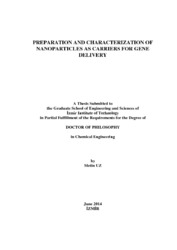Please use this identifier to cite or link to this item:
https://hdl.handle.net/11147/4226Full metadata record
| DC Field | Value | Language |
|---|---|---|
| dc.contributor.advisor | Altınkaya, Sacide | - |
| dc.contributor.author | Uz, Metin | - |
| dc.date.accessioned | 2014-12-03T14:54:06Z | - |
| dc.date.available | 2014-12-03T14:54:06Z | - |
| dc.date.issued | 2014-06 | - |
| dc.identifier.uri | http://hdl.handle.net/11147/4226 | - |
| dc.description | Full text release delayed at author's request until 2016.08.04 | en_US |
| dc.description | Thesis (Doctoral)--Izmir Institute of Technology, Chemical Engineering, Izmir, 2014 | en_US |
| dc.description | Includes bibliographical references (leaves: 127-141) | en_US |
| dc.description | Text in English; Abstract: Turkish and English | en_US |
| dc.description.abstract | In the first part of this thesis, a comprehensive characterization of polyethylene glycol (PEG) modified AuNPs designed for imaging or diagnostic purposed was carried out to investigate the effect of the size, PEG layer conformation and grafting density on the cellular uptake, toxicity and cell cycle phases against prostate (PC3), colon (CaCo2) cancer cell lines and 3T3 Swiss fibroblast cells. It was noticed that the cellular uptake and toxicity profiles of the particles varied depending on the size, surface properties and cell type. The particles were found to show alterations in cell cycle phases by causing DNA damage without apoptotic behavior at certain doses. In the second part of this thesis, efficient multilayer small interfering RNA (siRNA) delivery systems based on gold nanoparticles (AuNPs), cationic pentablock copolymers or fusogenic peptides were developed using cleavable disulfide bonds and electrostatic interactions. siRNA/Polymer (polyplexes) and siRNA/Peptide (peptideplexes) complexes formed by direct electrostatic complexation between siRNA and the cationic pentablock copolymers or peptides were used as controls, respectively. In addition, a conjugate siRNA delivery system based on the cleavable disulfide bonds between siRNA and fusogenic peptide was also proposed as an alternative system. The siRNA activity, toxicity, cellular uptake and intracellular distribution of the developed systems were investigated against luciferase-expressing SKOV3 ovarian cancer cell line. The use of cationic block copolymers or fusogenic peptides in AuNP based multilayer systems and complex systems, provided efficient siRNA condensation and protection from nuclease enzyme and serum protein degradation, in addition to cellular uptake, endosomal escape and siRNA activity in the cytoplasm. | en_US |
| dc.description.sponsorship | Izmir Institute of Technology Scientific Research Project Commission (Grant: 2009IYTE01) | en_US |
| dc.language.iso | en | en_US |
| dc.publisher | Izmir Institute of Technology | en_US |
| dc.rights | info:eu-repo/semantics/openAccess | en_US |
| dc.subject | siRNA delivery | en_US |
| dc.subject | Polyethylene glycol | en_US |
| dc.subject | Nanoparticles | en_US |
| dc.title | Preparation and Characterization of Nanoparticles as Carriers for Gene Delivery | en_US |
| dc.title.alternative | Gen Taşınımı için Nanotaneciklerin Hazırlanması ve Karakterizasyonu | en_US |
| dc.type | Doctoral Thesis | en_US |
| dc.department | Thesis (Doctoral)--İzmir Institute of Technology, Chemical Engineering | en_US |
| dc.relation.publicationcategory | Tez | en_US |
| dc.identifier.wosquality | N/A | - |
| dc.identifier.scopusquality | N/A | - |
| item.openairecristype | http://purl.org/coar/resource_type/c_18cf | - |
| item.cerifentitytype | Publications | - |
| item.fulltext | With Fulltext | - |
| item.languageiso639-1 | en | - |
| item.grantfulltext | open | - |
| item.openairetype | Doctoral Thesis | - |
| Appears in Collections: | Phd Degree / Doktora | |
Files in This Item:
| File | Description | Size | Format | |
|---|---|---|---|---|
| 10012923.pdf | DoctoralThesis | 4 MB | Adobe PDF |  View/Open |
CORE Recommender
Page view(s)
338
checked on Apr 28, 2025
Download(s)
176
checked on Apr 28, 2025
Google ScholarTM
Check
Items in GCRIS Repository are protected by copyright, with all rights reserved, unless otherwise indicated.